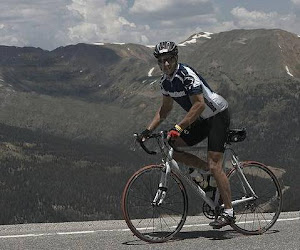Last week, I posted a blog on Cycling Nutrition. In that blog, I discussed the importance of Carbohydrate intake not only during competition but during endurance training.
Here's a chart I came across that depicts your body's fuel useage during continuous exercise. What the chart/graph doesn't show is the intensity level. I'm assuming this is moderate such as the bike leg of an Ironman competition. Why am I assuming that? Well, if it were low intensity (continuous exercise) you could probably reserve muscle glycogen levels and burn primarily fat for fuel. If it were high intensity your body would be burning more glycogen/glucose and you probably wouldn't even make 2 hours (let alone 4+ shown).
What's interesting to note from the graph/chart is that your muscles only provide 50% of your total fuel (glycogen) when completed carb-loaded, your blood glucose 10% and fat reserve 40%. As exercise continues you can see that muscle glycogen levels drop. At the 2 hr. mark, your muscles are only providing approx. 30% of your body's total fuel useage. However, your blood glucose levels actually take up the slack and provide more (around 15%) fuel for exercise than it did at the start. After the 2 hr. mark you can see that if you don't consume any carbs during exercise (i.e. Gu's, Gatorade, food, etc.) that your blood glucose levels will start to tank. At the 3 hr. mark, your blood glucose levels will start to dip below 10% of your total body's useage. By the 4 hr. mark, your blood glucose levels will have tanked (in addition to your muscle glycogen reserve). This is the point where you "bonk". Exercising beyond this point will not only be difficult but detrimental to your health). Now, if instead at the 2 hr. mark you ingest some carbs (liquids act quicker), you will stave-off the dreaded "bonk". However, you can clearly see that regardless of how much carbs you ingest, you can NOT restore muscle glycogen levels to their full/orginal state. That's because your body can't process the intake of carbs quickly enough and your muscles need a rest (so to speak) to clear out the high acidity and repair themselves before glycogen resynthesis.
The most important takeaway from this chart/graph, I believe, is to ensure that BEFORE you start your long endurance training (or racing) that your Carb levels are topped-off to the max. You want your muscle glycogen levels maxed out as well as your blood glucose levels. Plus, anything you can do to spare muscle glycogen levels- the better. That is, ensure you're consuming Carbs during endurance exercise and/or train your body to utilize Fat for energy during low to moderate intensity levels. Problem with the latter is, it's NOT that easy to train your body to utilize fat for energy rather than Carbs. Well, it's not that it's not that easy, it's actually counter-productive to your workouts and NEVER recommended during racing season. Because to do so, you'll have to starve your body of Carbs so that the only choice it has is to consume Fat--and Protein. Be forewarned however, that if you increase exercise intensity on a Carb depleted body your body will start utilizing Protein for fuel- and I don't even want to begin to tell you how counter-productive (dangerous) that is. Plus, if memory serves me correct from my Exercise Physiology studies, you can't burn Fat without the presence of Carbs..another reason NOT to try to target Fat alone for fuel useage.
Note: Glycogen depletion will happen MUCH faster if the intensity level is increased. Instead of muscle glycogen being depleted at the 4 hr. mark (shown above) it could happen at the 2-3 hr. mark.
Power ON! Coach Rob
Wednesday, February 2, 2011
Subscribe to:
Post Comments (Atom)






No comments:
Post a Comment